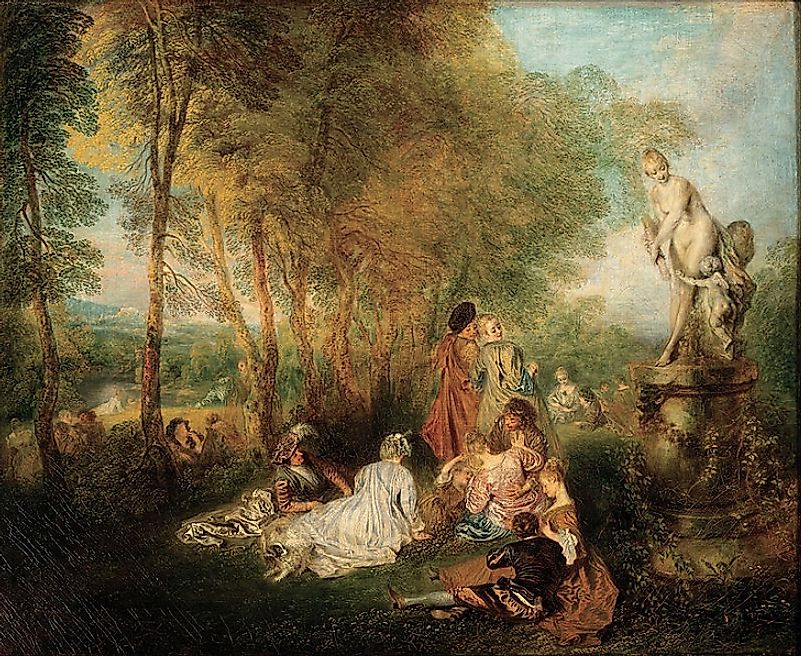What Was The Rococo Art Movement?

Rococo was an 18th Century art movement originating from France. Its works were said to be more graceful and ornate than those of the earlier Baroque movement. Rococo style developed as an alternative to the highly restrictive Baroque Style and celebrated sophistication, elegance and, asymmetrical and ornamental designs. The style was first adopted in interior design and quickly spread into other artistic disciplines such as sculpting, painting, architecture, music, and many more. The Rococo Art Movement is discussed below.
5. Overview of the Style -
The Rococo Style used a lighter and more elegant approach to interior design than its predecessors. The style was characterized by elaborate curved forms, mostly made to resemble letters ‘S’ and ‘C' asymmetry. Rococo art subsequently inspired numerous painters to produce work that was both sumptuous and light. The style was particularly embraced by the French aristocracy and spread to other European countries, chiefly Germany and Austria. In decorations, the style manifested itself in gold plaster work, organic patterns, intricate moldings, and gilding. Rococo furniture was characterized by sinuous silhouettes and was gilded in velour, leather or brocade. Rococo furniture was highly tasteful and elegant and boasted sophistication in their upholstery. Rococo style shied away from the religious and political themes celebrated by the Baroque Style and embraced love, eroticism, sensuality, leisure and lush landscapes. Rococo Painters largely used light colors and pastels.
4. History and Development -
Before the style’s emergence, the dominant style under reign of Louis XIV in France was the Baroque style. The Palace of Versailles had been notably ornamented and designed in the Baroque style. After the end of his reign, his successors moved from Versailles and adopted a more lighter approach to interior design. The word Rococo was adopted from the French word rocaille, and it refers to the shell-covered rock work employed in decorating artificial grottoes. Architects such as Nicolas Pineau popularized the art in France and by the 1730s the style had spread to the sculpting and painting disciplines. The style adopted asymmetry, light colors, and oriental designs and was championed by French artists such as Antoine Watteau and Jean Berain. Outside of France, the style was soon embraced in Germany and Austria, and then spread into Italy and England.
3. Notable Artists and their Works -
One of the most famous Rococo painters was Antoine Watteau. Watteau created a new kind of painting category known as amorous festival paintings. These portrayed the aristocracy engaged in different leisure activities in the countryside. The Rococo painter Francois Boucher depicted religious themes in one of his most renowned works, ‘Saint Peter Attempting to Walk on Water.' He also produced other brilliant works such as ‘Portrait of Madame Pompadour’ and ‘Nude on a Sofa.' Rococo design was honed by practitioners such as Germain Boffrand, who was responsible for the salons of the Hotel de Soubise in Paris.
2. Decline and Subsequent Successive Movements -
Critics of the up-and-coming revolutionary era in France such as Voltaire sparked the art movement’s decline beginning in the 1760s. The Rococo style was criticized for its superficiality and ornamental excesses. The decline of the art coincided with the rise of the more serious Neoclassicism. Neoclassicism was championed by the successive Napoleonic governments, and overrode Rococo’s past dominance.
1. Legacy -
Several majestic landmarks in Europe today still attest to the elegance of Rococo art. Some of these landmarks include the Czapski Palace in Warsaw, Poland, Saint Andrew’s Church in Kiev, Ukraine, and Zwinger in Dresden, Germany. Rococo heavily popularized the use of portraits. Rococo painters depicted scenes of romantic love and even eroticism and promoted secularism in a mainly religious Europe. Currently, we still have Rococo furniture sold at premium prices across different parts of the world.











